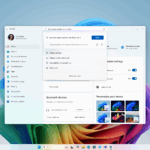New features including web traffic prioritization and a speed split screen setup are included in the most recent version of ChromeOS (M124). Together with these upgrades, also includes new gesture controls and a revamp of the settings user interface.
Windows users will be familiar with the new “Faster Split Screen Setup” functionality, based on screenshots released by 9to5Google. App previews appear on the opposite side of the screen when you snap an app to one side; select an app, and it will remain there for you. This change should reduce some of the friction caused by having to navigate to the second app and repeat the side-by-side pinning procedure.
According to 9to5Google, users may find the settings for this feature by going to Settings > System preferences > Windows and desks.
Additionally, Google updated ChromeOS to include Wi-Fi Quality of Service (QoS). Similar to routers’ QoS feature, the idea is that when your Wi-Fi network is busy, your Chromebook will give priority to things like online gaming and video calls. If it performs according to plan, this would result in better video calls, fewer buffering during streaming, and more fluid online gaming.
The latest version of ChromeOS has carrier locking, which allows wireless operators to sell you a Chromebook that is exclusive to their service. This falls into the category of “things nobody asked for.” Theoretically, your carrier will unlock the laptop after you pay off the debt or the contract expires, which I’m sure will always work flawlessly.
/cdn.vox-cdn.com/uploads/chorus_asset/file/25433258/ChromeOS_124_faster_split_screen.png)
Finally, Chrome Unboxed reports that this version includes a revamped ChromeOS settings interface that is cloaked in Google’s Material You design and organized more like smartphone settings menus. According to the report, ChromeOS now supports turning on the ability to digitally pan, tilt, and zoom even on Chromebook webcams that don’t support Super-Res Zoom. There’s also a new 2-finger trackpad gesture for swiping away notifications.
Google states that eligible Chromebooks will receive version M124 “over the coming days,” although unlike most of its updates, it doesn’t release ChromeOS versions all at once. You can use the “Update available” notification or navigate to Settings > About ChromeOS > Check for updates to see if the update is available.
Discover more from TechBooky
Subscribe to get the latest posts sent to your email.








